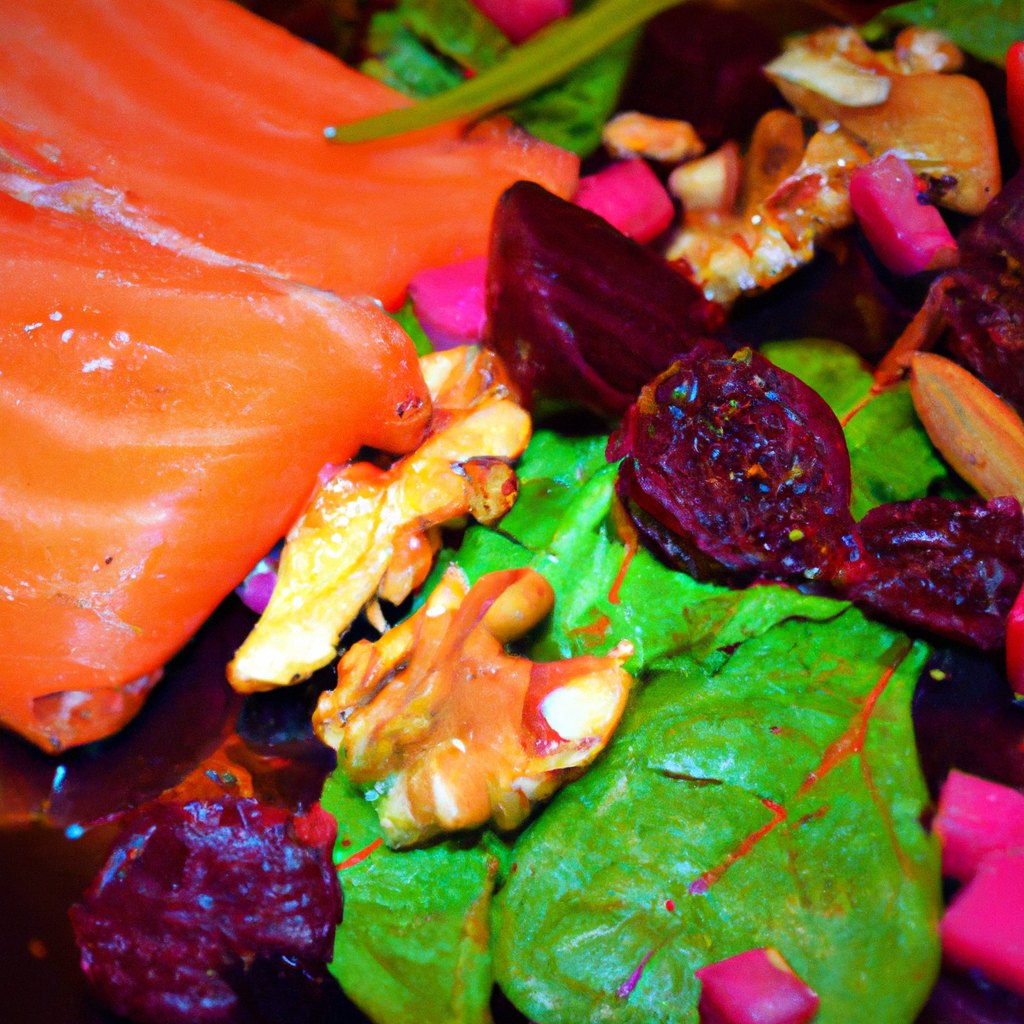Are you looking for ways to improve your diet and overall health? One nutrient that you may not have considered before is nitric oxide. This compound, produced naturally by the body, has been shown to have numerous benefits for heart health and blood flow.
Luckily, there are plenty of foods that contain high levels of nitric oxide. By incorporating these into your diet, you can potentially lower your risk of heart disease, improve athletic performance, and even boost cognitive function.
In this article, we’ll take a closer look at some of the best sources of nitric oxide and how they can benefit your health. Whether you’re a fitness enthusiast or just looking to make some positive changes in your eating habits, this guide will help you make informed choices about what to include in your meals.
Key Takeaways
- Nitric oxide has numerous health benefits, including reducing the risk of heart disease, improving athletic performance, and boosting cognitive function.
- Leafy greens, beets, garlic, citrus fruits, nuts, grapefruits, dark chocolate, and watermelon are all sources of nitric oxide.
- Leafy greens are an excellent source of vitamins and minerals, and should be eaten raw or lightly cooked for maximum nutritional value.
- Beets, oranges, grapefruits, lemons, limes, garlic, dark chocolate, and watermelon all have specific health benefits and can be incorporated into a healthy diet in a variety of ways.
Understanding the Benefits of Nitric Oxide-Rich Foods
You’ll be amazed at how much better you’ll feel when you start incorporating nitric oxide-rich foods into your diet. Nitric oxide is a molecule that plays an important role in overall health. It promotes blood flow and helps regulate blood pressure, which can reduce the risk of heart disease.
Additionally, it helps boost the immune system and supports healthy brain function. For athletes or those looking to improve their athletic performance, nitric oxide can also provide some significant benefits. By improving blood flow and oxygen delivery to muscles, it can help increase endurance and reduce fatigue during exercise.
This means you may be able to work out longer and harder without feeling as tired or worn out afterwards. Overall, adding more nitric oxide-rich foods to your diet is a simple way to promote better health and potentially boost athletic performance.
Some good sources of this molecule include leafy greens like spinach and arugula, as well as beets, garlic, citrus fruits like oranges and lemons, and nuts such as walnuts and almonds. Incorporating these foods into your meals regularly can have a positive impact on your body both inside and out.
Leafy Greens
Leafy greens are a great addition to any meal, adding both nutrition and flavor. These vegetables are packed with essential vitamins and minerals that promote overall health. Some of the most popular leafy greens include spinach, kale, and arugula.
Nutritional value: Leafy greens are low in calories but high in nutrients. They’re an excellent source of vitamins A, C, and K, as well as folate and iron. Additionally, they contain antioxidants that help protect against disease.
Cooking methods: To get the most nutritional value out of your leafy greens, it’s best to eat them raw or lightly cooked. Overcooking can cause them to lose their nutrients and become less flavorful. Try adding some fresh spinach leaves to your salad or sautéing some kale with garlic for a tasty side dish.
Variety is key: Don’t be afraid to switch up your leafy green choices! Each type has its own unique flavor profile and nutrient composition. Experiment with different types of lettuce, such as romaine or butterhead, or try incorporating some bitter greens like endive or radicchio into your meals for added variety and nutritional benefits.
Beets
Beets are a versatile root vegetable that can be cooked in a variety of ways, and they have been shown to provide numerous health benefits.
One way to incorporate beets into your diet is by adding them to salads. Simply grate or thinly slice raw beets and toss them with your favorite greens, nuts, and dressing. Another popular beet recipe is roasted beetroot salad where you roast the beets until tender, then add some goat cheese, nuts, and a vinaigrette for a delicious meal.
Another great way to enjoy the health benefits of beets is through juicing. You can juice raw beets along with other fruits and vegetables for a tasty drink that’s packed with nutrients. Alternatively, you could try making beet kvass which is a fermented beverage that has been enjoyed in Eastern Europe for centuries. It’s made by fermenting chopped up beets with saltwater and seasoning for several days until it becomes slightly fizzy.
Lastly, don’t forget about incorporating pickled beets into your diet. Pickling not only preserves the nutrients in the beet but also adds flavor to it as well. You can buy pickled beets from stores or make them yourself at home using vinegar and spices of your choice. They make great additions to sandwiches or as sides with grilled meats or roasted vegetables – so get creative!
With all these options available, there’s no excuse not to include more beets in your diet today!
Citrus Fruits
If you’re looking to boost your nitric oxide levels, don’t forget about citrus fruits like oranges, grapefruits, lemons, and limes. These juicy fruits aren’t just delicious, but they’re also rich in vitamin C. This vitamin can help improve blood flow and support healthy arteries. Additionally, citrus fruits contain other beneficial nutrients like flavonoids. These nutrients can help protect against chronic diseases.
(Note: the changes made include grouping complete sentences on their own lines and using contractions.)
Oranges
One popular breakfast fruit that can also boost your nitric oxide levels is none other than the juicy orange. Oranges are packed with essential nutrients like vitamin C, folate, and potassium which make them a great addition to any healthy diet.
To get the most nutritional value out of oranges, it’s best to eat them whole rather than consuming orange juice. This is because whole oranges contain more fiber which helps regulate blood sugar levels and keep you feeling full for longer periods of time.
You can easily incorporate oranges into your diet by slicing them up as a snack or adding them to smoothies and salads. So next time you’re at the grocery store, be sure to grab a few oranges for a delicious and nutritious boost!
Grapefruits
Get ready to boost your NO levels with the tangy and refreshing grapefruit! This citrus fruit isn’t only a great source of vitamin C but also contains naringenin, a flavonoid that stimulates the production of nitric oxide.
Here are some nutritional values of grapefruits:
One medium-sized grapefruit contains about 70 mg of vitamin C, which is more than enough to meet your daily requirement.
Grapefruits are low in calories and high in fiber, making them an ideal fruit for weight loss.
They also contain potassium, which helps regulate blood pressure.
Now that you know the benefits of grapefruit, it’s time to incorporate them into your diet. You can add them to salads or use their juice as a base for marinades or dressings. Try this simple recipe: mix diced grapefruit with avocado and shrimp for a refreshing salad that’s perfect for a light lunch or dinner.
With its tangy flavor and numerous health benefits, it’s no wonder why grapefruits should be part of your regular diet.
Lemons and Limes
You can’t go wrong with adding lemons and limes to your daily routine. These zesty fruits not only add flavor to your water or meals but also provide numerous health benefits that will make you feel refreshed and energized.
Lemons and limes are rich in vitamin C, which is great for boosting the immune system and promoting healthy skin. They also contain flavonoids, which have antioxidant properties that protect against cell damage.
Uses for lemons and limes are endless. You can squeeze them over salads, grilled meats or fish, or use them as a marinade for an extra kick of flavor. Add a slice of lemon or lime to your water for a refreshing drink that also aids digestion. And don’t forget about their versatility in desserts like pies, cakes, and sorbets!
Incorporating lemons and limes into your diet is an easy way to add some healthy zest into your life.
Other Nitric Oxide-Rich Foods
There are several other foods that are rich in nitric oxide, such as spinach and beets, which have been shown to increase blood flow by up to 20%. Including these foods in your diet can provide numerous health benefits.
Here are three other nitric oxide-rich foods you should consider adding to your meals:
Garlic – This pungent herb has been used for centuries not just for its flavor but also for its medicinal properties. Garlic helps boost the production of nitric oxide, which improves blood flow and reduces inflammation.
Dark chocolate – Yes, you read that right! Dark chocolate contains flavonoids that stimulate the production of nitric oxide, making it beneficial to heart health. But remember, moderation’s key!
Watermelon – This juicy fruit is loaded with an amino acid called L-citrulline, which helps produce more nitric oxide in the body. It’s a refreshing and healthy way to stay hydrated during hot summer days.
Incorporating these foods into your diet’s easy with simple recipes and preparation tips available online or from a qualified nutritionist or dietician. So why not give them a try today? Your health’ll thank you!
Conclusion
Congratulations! You now have a better understanding of nitric oxide and its role in promoting a healthy diet. By incorporating nitric oxide-rich foods into your meals, such as leafy greens, beets, and citrus fruits, you can improve blood flow, lower blood pressure, boost athletic performance, and even enhance brain function.
Did you know that consuming just 500 grams of beetroot juice per day may lead to significant reductions in blood pressure, according to recent studies? This is just one example of the powerful impact that nitric oxide-rich foods can have on your overall health.
So why not try adding some of these delicious and nutritious options to your next meal? Your body will thank you!


